Rochester’s trees are celebrated, but not everyone gets to have their time in the shade
This story was produced as part of a larger project for the USC Annenberg Center for Health Journalism’s 2021 Data Fellowship.
Other stories by Justin Murphy include:
This project mapped every tree in Rochester. Here’s how we did it
How did some Rochester neighborhoods become greener than others?
‘I now see the disparity is real.’ For Rochester’s mayor, trees are a justice issue
Walk through Rochester's Washington Grove, a rare remnant of nation's old-growth forests
Sign up to learn about Rochester's trees by texting with reporter Justin Murphy
Tell us the story of your favorite tree in Rochester. Where is it and why is important?
Read about Rochester’s most beloved trees and share your own story
Rochester's trees make Landmark Society of Western New York's annual 'Five to Revive' list
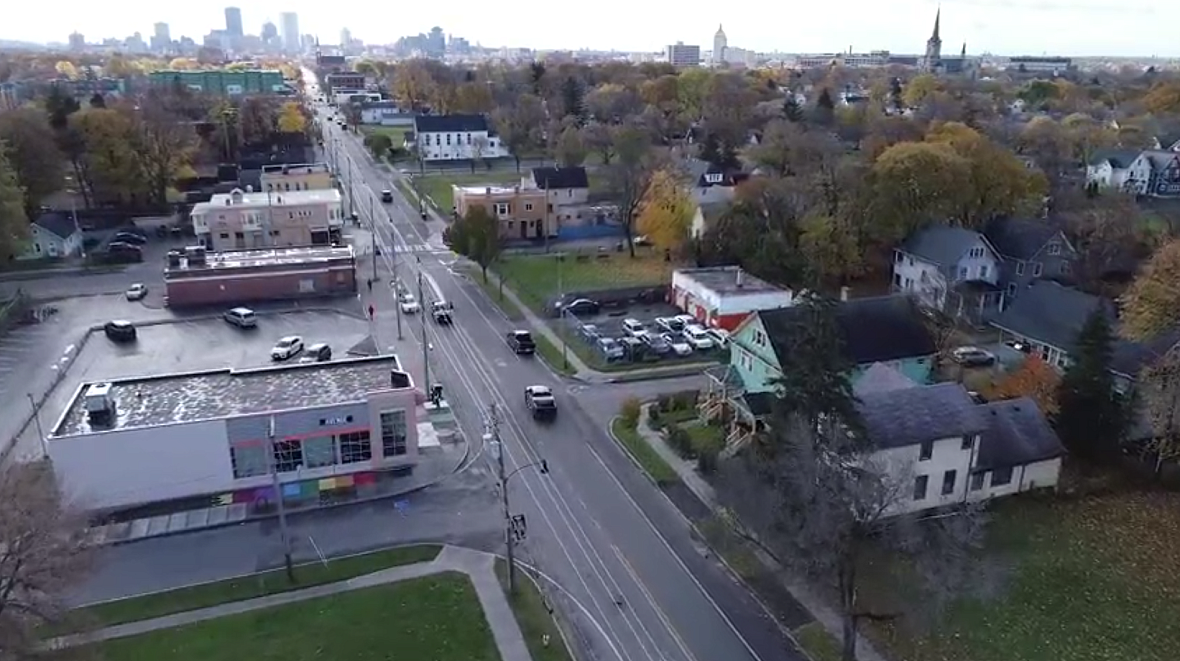
Drone footage of Joseph Avenue at Berlin Street shows a lack of trees and canopy in this part of Rochester
SHAWN DOWD AND TINA MACINTYRE-YEE / ROCHESTER DEMOCRAT AND CHRONICLE
Set back a few dozen feet in a scrubby clover field at Joseph Avenue and Berlin Street, ringed by bollards and chain-link fencing, stands a tree covered in wishes.
They're written on thin banners of red, yellow, black and white, tied down on both ends to guard against the whipping wind.
"I wish for Black heritage to take the forefront to inspire and inform."
"My wish is to stop all violence and bad people."
"I wish everyone could heal so they can find purpose."
The messages belong to members of Avenue BlackBox Theatre across the street.
Banner ribbons with wishes written on them hang from a box elder tree in an empty lot along Joseph Avenue. The wishes were written by members of The Avenue BlackBox Theatre, which is across the street. SHAWN DOWD/DEMOCRAT AND CHRONICLE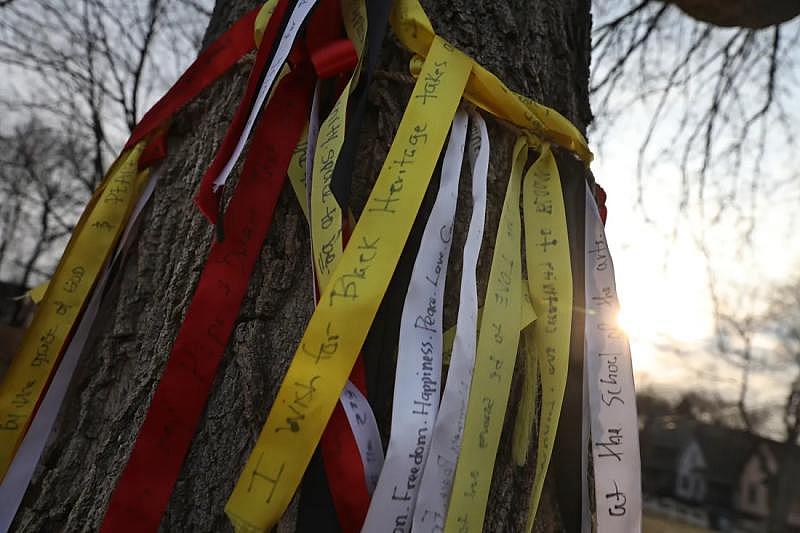
"There are many things we draw inspiration from," the theater's founder and director, Reenah Golden, said. "We want to start with nature first and foremost."
This tree, a towering box elder, is at the center of the vision. It is also one of the few significant trees on this stretch of Joseph Avenue, a corridor that is one of the city's poorest and also one of the least tree-covered. The combination of those two factors is not a coincidence.
‘No trees, no shade’
For this series of stories, the Democrat and Chronicle assembled a comprehensive data set related to trees, air quality and health outcomes in the city of Rochester, including state-of-the-art granular tree cover data from EarthDefine.
It shows disparities in tree cover across Rochester that are rooted in public policy choices going back more than a century.
Tree canopy data via EarthDefine; percent renters via U.S. Census American Community Survey 2019; temperature from NASA/USGS Landsat Program.
Rochester, like many cities in the United States, has a tree equity problem. The neighborhood around Joseph Avenue and Upper Falls Boulevard has a tree canopy covering 18% of the land, one of the lowest marks in the city. It also happens to be one of the poorest places in the city. Nearly all the residents are Black and Hispanic, and nearly all of them are renters rather than homeowners.
People living in this neighborhood have higher rates of physical and mental health issues. And the air is hotter on a typical summer day. Now look across town at Highland Park. Here the tree canopy covers 49% of the land, the highest mark in the city. Here, the air is more than five degrees cooler than the city median on a summer day. Rates of asthma and poor health are among the lowest in Rochester. A similar pattern can be observed around Rochester: neighborhoods with more renters, more poverty and fewer white people have fewer and smaller trees, with observable effects on air quality, temperature and health.
REPORTING BY JUSTIN MURPHY, ROCHESTER DEMOCRAT AND CHRONICLE. DESIGN AND DEVELOPMENT BY CHRIS AMICO, USA TODAY NETWORK STORYTELLING STUDIO.
"You can see when you just walk or drive around this part of town – you just don’t see trees," said Luis Burgos, the former director of Recreation and Youth Services in the city of Rochester, who grew up on Joseph Avenue. "In the summer it’s just so bright. Then when you go on Park Avenue and those side streets, it’s so comfortable."
Historically speaking, the wealthy and politically powerful areas of the city were laid out from the beginning with an eye toward beautification. Northeast Rochester, the traditional landing place of immigrants, was not. The disparity has been compounded by countless everyday choices over the last century.
The city today recognizes the need to add tree cover in certain neighborhoods, particularly in the northeast quadrant. But beyond the stated enthusiasm of Mayor Malik Evans and others in the first months of his administration, there is little evidence of a concrete plan to do so.
You can see when you just walk or drive around this part of town – you just don’t see trees. In the summer it’s just so bright. Then when you go on Park Avenue and those side streets, it’s so comfortable. - Luis Burgos, former director of Recreation and Youth Services in Rochester
The city forestry division removes more trees than it plants each year, and new trees go mostly where residents have requested them — typically skewing toward neighborhoods that are already relatively well covered.
Many cities across the country have come up with more thorough plans to address tree equity. Most of them involve significant public-private partnerships, as well as major outreach to residents who might be unenthusiastic about more trees near their homes.

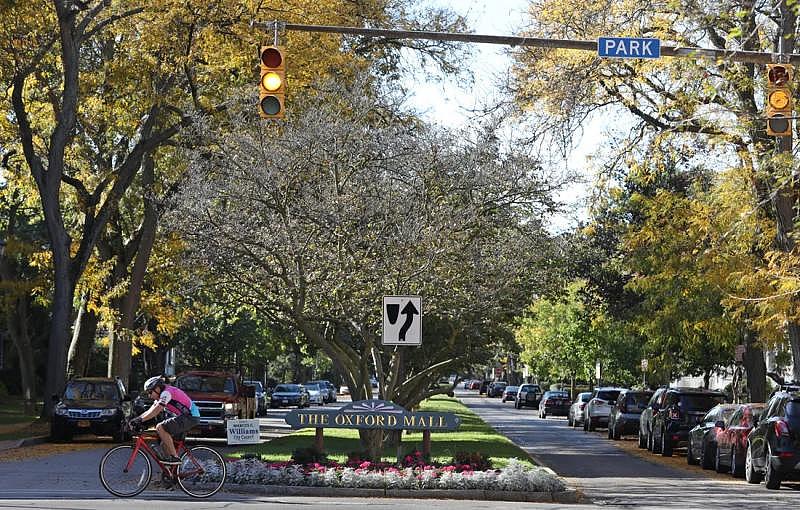
The 700 block of Joseph Avenue has a sparse tree canopy, while the Oxford Mall on Oxford Street is known for its tree cover, including magnolia trees that flower in spring.SHAWN DOWD / ROCHESTER DEMOCRAT AND CHRONICLE
Reenah Golden and her teen fellows at Avenue BlackBox Theatre hope to be part of the solution. The Berlin Street lot will have not just trees but also totem poles designed with help from muralist and public artist Shawn Dunwoody.
Their goal is to create a sacred space — a way to address climate change, racial inequality and community trauma, one vacant lot at a time.
"When you’re walking down Joseph Avenue, it’s not a very walkable avenue – and it’s because there’s no trees, no shade," Golden said. "We need to infuse the arts and nature and beauty into this area that’s just desolate in that sense right now."
A walk through Jones Square Park. SHAWN DOWD / ROCHESTER DEMOCRAT AND CHRONICLE
Concrete public health benefits
Sergio Vergara lives across the street from Jones Square Park, one of several small parks in the city designed by Frederick Law Olmsted (of New York's Central Park fame). The broad lawn is studded with dozens of mature trees, with footpaths leading toward a central fountain.
Stout red oaks, soaring silver maples and spreading sugar maples. They're all a part of Vergara's daily routine.
"I just sit out here in the morning, sip my coffee and look at all those leaves," he said. "That's what really makes me feel like: 'Wow.'"
It’s not just, ‘Oh, the trees are so pretty.’ There are very concrete public health benefits associated with nature. - Eugenia South, faculty director of the Urban Health Lab at the University of Pennsylvania
That "wow" is firmly backed by research.
"It’s not just, ‘Oh, the trees are so pretty,'" said Eugenia South, faculty director of the Urban Health Lab at the University of Pennsylvania. "There are very concrete public health benefits associated with nature."
Scientists have demonstrated that increased access to green space, and trees in particular, brings about a host of health benefits, with better mental health perhaps at the top of the list.
One large-scale study showed that people who lived more than 1 kilometer away from significant green space reported 42% higher stress levels. Studies have also shown participants experience less mental fatigue after even very brief periods in nature.
In Rochester, residents living in the neighborhoods with the fewest trees are also more likely to report poor mental health than those in neighborhoods with the most trees. Scientists have found that the effect is apparent even when other factors, including poverty, are taken into account.
Scientists have also found a relationship between tree canopy and physical health, including overall mortality. One major study observed areas where ash trees had been lost due to the emerald ash borer and found a significant increase in deaths due to cardiovascular problems in places where the beetles had caused the greatest damage.
It is possible to overstate or oversimplify the benefits of trees in cities. The pollen and chemicals that some trees emit, for instance, can worsen rather improve asthma rates, making species selection a critical factor for urban foresters.
"There’s still some back-and-forth over the full extent of the benefits in terms of pollution," said Nina Bassuk, director of Cornell University's Urban Horticulture Institute. "(But) there are well documented benefits for stormwater capture, heating and cooling, pollinator habitat, carbon sequestration and air and water quality improvement."
A drive along Ford Street, where trees are scarce. SHAWN DOWD / ROCHESTER DEMOCRAT AND CHRONICLE
Blocking heat and creating bonds
Trees' most vital contribution to urban areas — particularly as climate change leads to rising temperatures — may be their ability to defeat the heat.
The more heavily a city is paved, the more susceptible it is to the urban heat island effect. Streets and sidewalks absorb heat and slowly radiate it back out, making the air much warmer than it would be in a greener section of the same town.
Leafy trees interrupt that process and also help cool the immediate area by exhaling water, a process known as transpiration.
"When it gets hotter there’s a tremendous amount of deaths that occur – typically people without air conditioning, maybe not in the greatest health," Bassuk said. "We've seen that around the world. And trees make a huge difference in terms of cooling."
Satellite temperature data gathered by the U.S. Geological Survey shows a spread of more than 12 degrees across Rochester on a typical summer day. Much of that distinction has to do with trees and other green space, or the lack thereof.
The last hot spell of 2021 came in mid-October, when for a few days the overcast October sky lifted and temperatures rose to near 80 degrees.
And so the old folks at Ruff Alley had a cookout.
The OGs, they call themselves: a loose group of 20 or so people, mostly retirees, living within a few blocks of one another on Jefferson Avenue. When the weather is good, they'll wander over to this vacant lot around noon to banter and pass the time.
There's not always food, but there was on this day. Groaning platters of ribs and chicken, all home-cooked and seasoned to perfection.
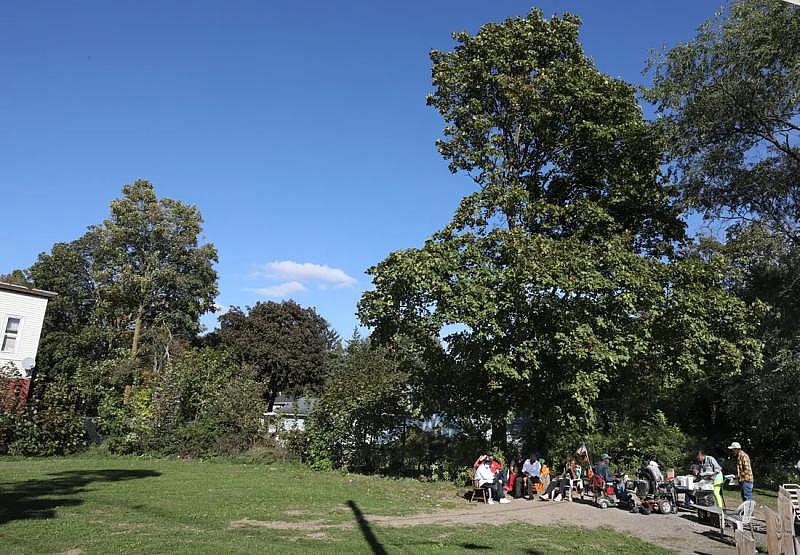


Neighborhood residents enjoy a barbecue lunch together in a vacant lot at the corner of Jefferson Avenue and Ruff Alley. Residents of the neighborhood like to hang out in the lot and take advantage of the shade the trees there provide, along with the open space of the lot.SHAWN DOWD / ROCHESTER DEMOCRAT AND CHRONICLE
The OGs sat around placidly waiting for the tuna salad to arrive, scooching their folding chairs under the shade of a single maple tree until it disappeared over a chain link fence.
Maximillian Cherry leaned back in his chair and gave thanks for a cool breeze — not only because of the barbecue scent it carried.
A Navy veteran, he's been passing the time under this tree for years. Like the rest of the OGs, he said he has become accustomed to the lack of green space or other environmental amenities.
"They forgot about us when they were doing the upgrades," he said. "The only upgrade we get is white lines on the street."
Rich people get tall trees; poor people get short trees. Why is that? They got more fertilizer than we do? - Tyrone Womack
This block is actually above the median in the city of Rochester in terms of tree canopy. But Jefferson Avenue itself has only sparse tree cover, and most people in the neighborhood don't have air conditioning, making this maple tree not only a social gathering spot but also a welcome place to cool down.
Tyrone Womack arrived too late for a spot under the tree and so had to settle for the shade of a parked SUV, Al Green pouring from its radio.
“Rich people get tall trees; poor people get short trees," he said. "Why is that? They got more fertilizer than we do?"
A drive down tree-lined Central Park. SHAWN DOWD / ROCHESTER DEMOCRAT AND CHRONICLE
City lacks tree equity plan
Erasing the disparities in Rochester's tree canopy is more complicated than simply planting more trees. But it certainly will require planting more trees.
Unfortunately, the city's forestry division hasn't been empowered to plant enough of them. Each year the city removes more trees than it plants, forester Andrew Place said, a problem that ultimately traces back to the budget.
From 2015 to 2021, the city of Rochester planted about 4,400 trees but removed about 5,400, a net decrease of 1.5% in city-maintained trees.
What's more, the trees that do get planted are done so mostly according to resident requests, a policy that skews the growth of the urban forest toward wealthier and better resourced areas that already have many trees.
"We certainly see requested trees in certain areas more than others," said Brian Liberti, the former city forester and current director of parks and buildings. "Anywhere we have a high population of rental properties, a lot of those renters are not requesting trees to be planted."
The city has done some additional planting in the northeast quadrant in recent years, Liberti said, including in a partnership with the nonprofit group Greentopia. It has also begun to distribute flowers to residents with newly planted trees, in the hope that the trees will get watered at the same time the flowers do.
Otherwise, Liberti conceded, there is no plan in place to address tree equity in the city.
Rochester Mayor Malik Evans and City Council Finance Committee Chairman Mitch Gruber both said they hope to rectify that problem, in part through the use of American Recovery Plan Act (ARPA) stimulus funding.
The first step, Gruber said, is creating a new urban forest master plan. The current document, last updated in 2012, says little about disparities across the city.
"We need to update it and recognize we have some resources to bear to deliberately address the tree canopy as it relates to equity," he said.
"I don’t think the city has invested enough in parks for the last several years. This is a great time, not just to spend the money on planting, but also on staffing up and creating a longer-term maintenance plan."
Source: City of Rochester Division of Forestry. Includes only city-maintained trees.
Junior Rodriguez has not waited for the city to act. When he moved into his house on North Street 28 years ago, nothing was planted except for a single rose bush.
Now both edges of his property are lined with trees he has requested from the city. He cares for them obsessively along with the bulging vegetable garden he and his wife tend in the side yard.
When they're done working, they sit in the backyard under the shade of a single massive tree amid a cacophony of carousel horses.
"The house was empty, but every year I add something," he said. "I breathe the nice air. I'm peaceful."


Junior and Carmen Rodriguez talk about their love of trees and plants at their North Street home.SHAWN DOWD / ROCHESTER DEMOCRAT AND CHRONICLE
‘A lot of hopes and dreams’
Sadie Redfield thinks there are too many trees as it is.
City of Rochester Department of Environmental Services, Parks Operations & Forestry crew Stefan Gassaway, left, and Darien Cotten plant a tree along the 400 block of Blossom Road. SHAWN DOWD, DEMOCRAT AND CHRONICLE
She's owned her home on Joseph Avenue near Boston Street since 1978. The mature trees by her backyard cast enough shade to cover her deck, but she wishes the city would cut them down. The same goes for the ones in an adjacent vacant lot, which she said provide habitat for ticks and cover for the criminal-minded.
Redfield rejected the city's offer to plant a pear tree in front of her house because she's allergic to bees. And she has no interest in raking more leaves.
"Nobody's going to come by to pick up all this," she said, pointing warily at fallen leaves skittering along the curb.
Such resistance to tree planting is more than anecdotal. Data and interviews show it is widespread in some neighborhoods of Rochester and other cities and can have a major effect on whether trees thrive.
The city's tree inventory database, obtained via Freedom of Information request by the Democrat and Chronicle, shows scores of cases where property owners refused the trees that the city hoped to plant nearby.
"Some places you plant a tree and they water it and wrap it up in the winter to protect it," Place said. "Other places you come back later that year and it’s broken in half."
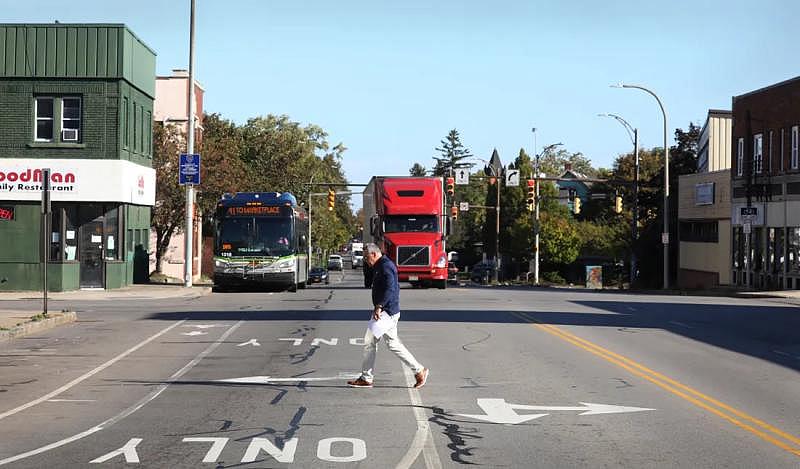
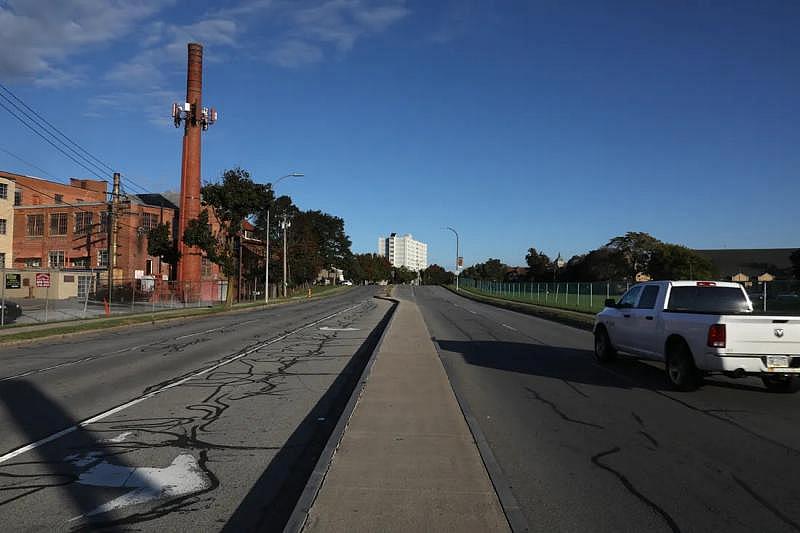

South Goodman Street near Highland Park has plenty of tree cover, while places like Ford Street and North Goodman Street are largely devoid of trees
SHAWN DOWN / ROCHESTER DEMOCRAT AND CHRONICLE
Researcher Christine Carmichael looked into that phenomenon in Detroit, where a quarter of eligible residents declined street trees near where they lived. She found that opposition to trees was often rooted in mistrust that the city would maintain them properly as well as a sense of frustration at being excluded from the process.
"Residents facing greater challenges to neighborhood upkeep desired more dialogue and information regarding tree maintenance and assistance available after tree planting, in addition to decision-making power in species planted," Carmichael concluded.
When it gets hotter there’s a tremendous amount of deaths that occur – typically people without air conditioning, maybe not in the greatest health. We’ve seen that around the world. And trees make a huge difference in terms of cooling. -Nina Bassuk, director of Cornell University's Urban Horticulture Institute
One of the most promising urban greening projects in the United States is Green Heart Louisville in Kentucky. There, the University of Louisville is partnering with a dedicated nonprofit agency and the city government to create meaningful resident involvement and to study outcomes, both for the environment and the community.
"A community isn’t monolithic, so what are the concerns and how do we address those in the project?" said Natasha DeJarnett, an environmental scientist taking part in the initiative. "Strategic partnerships and really strong community engagement are the heart of what ensures the effectiveness of the project."
Chris Widmaier, executive director of Rochester Ecology Partners, center, identifies different tree types from their leaves with DeShawn Griffin, left, including the tulip tree leaf that he holds, during a walk around Washington Grove in Rochester with students participating in the Seneca Park Zoo Society's Urban Ecologist program. SHAWN DOWD, DEMOCRAT AND CHRONICLE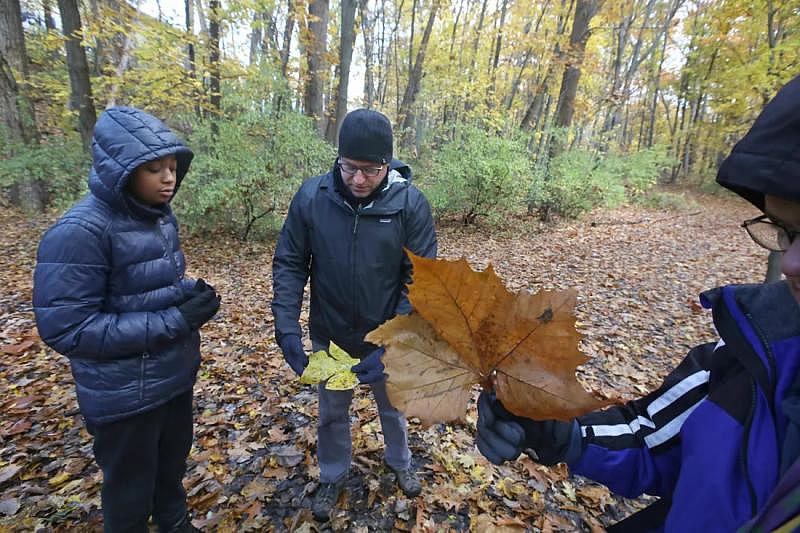
That engagement has yet to sprout in Rochester, but some early buds have begun to emerge. BlackBox's MUSE on the Avenue is one of several:
- Cornell Cooperative Extension Monroe County recently received funding from the University of Rochester Environmental Health Sciences Center for an educational outreach project in the Marketview Heights neighborhood, together with small-scale tree planting this fall.
- The group Inclusive Woods & Us, founded by Lucienne Nicholson, has the mission of increasing access to the outdoors for people of color and those who are economically disadvantaged.
- Chris Widmaier, a former Rochester City School District science teacher, runs several programs meant to connect Rochester children with nature through his organization, Rochester Ecology Partners.
- The Friends of Washington Grove, a nonprofit group that supports the 26-acre old growth remnant in Cobbs Hill Park, is reorienting its attention to promote access to green space for all city residents.
- Flower City NOIRE Collective founders Tonya Noel Stevens and Kristen Walker seek, in their words, to "fill the void of safe, Black-centered spaces in Rochester," including through urban gardening and a connection to the natural world more generally.
- Greentopia, the environmental advocacy and community organizing group, has participated in greening projects in northeast Rochester.
Of all the wishes tied to the box elder tree across from BlackBox, Jac Burch's is the most specific: to win an Oscar.
Banners with wishes written on them hang from a box elder tree in an empty lot along Joseph Avenue. SHAWN DOWD, DEMOCRAT AND CHRONICLE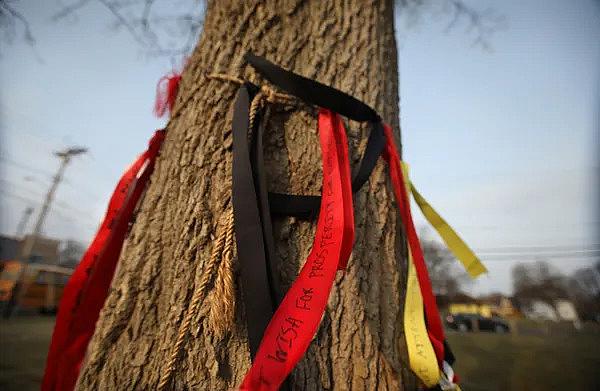
The 17-year-old was doing some filming around the tree recently when they came across a parade of unfamiliar insects.
Burch, who uses the pronouns they/them, stopped to watch. The colors; the movement; the pattern.
It was a moment to slow down.
Trees mean calmness and peace, they said. That is what Burch and the rest of the BlackBox fellows, hope to spread through the neighborhood and the city.
"A lot of people put their hopes and dreams on that tree," they said. "And they really want to see them fulfilled."
Contact staff writer Justin Murphy at jmurphy7@gannett.com.
[This story was originally published by Democrat & Chronicle.]

